OCZ's HSDL: A New Storage Link For Super-Fast SSDs
SATA 6Gb/s not fast enough? OCZ's new High-Speed Data Link serves up to 2 GB/s through a PCIe-like connection. Complementing the interface technology is a similarly-new 3.5" SSD called IBIS. Rated for up to 120,000 IOPS, enthusiasts should take note.
The IBIS SSD
So, the interface is one part of today’s story. The HSDL-compatible drive is the other.
For all intents and purposes, the technology underlying HSDL is completely transparent to the enthusiast or IT administrator that sets it up. Plug in the controller card, attach the SFF-8087 connector to the 3.5” drive, plug in a SATA power cable, install the Silicon Image drivers and go.
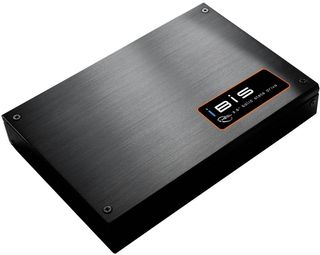
But I couldn’t resist dismantling the thing.
Inside the IBIS, you’ll find three boards. There’s one controller board hosting the SAS/power connections and a 3 Gb/s Silicon Image SiI3124 PCI-X-to-four-port-SATA controller, which snaps into an internal backplane. Two other boards are loaded down with 34 nm MLC NAND from Intel, along with a pair of SandForce SF-1200 controllers each. Each one of these appears as a 55 GB drive in the Silicon Image controller BIOS.
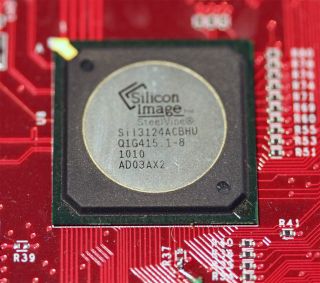
If it helps, think of the IBIS as very similar to the RevoDrive X2 that SandForce was showing off at IDF 2010. Only, instead of dropping into a PCI Express x4 slot, the IBIS plugs into a controller that drops into a PCI Express x4 and communicates over an interface that is in no way throughput-constrained today. Architecturally, though, both drive products are really very similar.
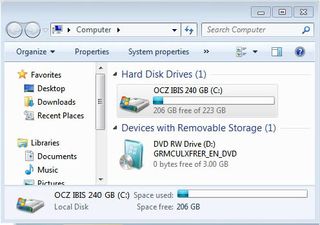

Of course, the IBIS is bootable, and although Windows 7 doesn't include the driver for Silicon Image's controller, adding once Windows 7 setup reports that it didn't find any drives lets the OS see the SSD and install to it. Although there are 256 GB worth of NAND chips and OCZ advertises our sample as a 240 GB offering, you actually get 223 GB of usable space. This is a result of 1) a binary to decimal conversation and 2) over-provisioning on OCZ's part.

The sample OCZ sent over boasts 128 GB of flash per board (256 GB total), though the drive’s advertised capacity is 240 GB. In essence, what you’re getting is an array of 128 GB flash-laden boards inside that 240 GB model. Technically, this isn’t actually RAID 0; OCZ employs Frame Information Structure (FIS)-based switching, allowing the Silicon Image IC to talk to all four SandForce controllers simultaneously and facilitating the aggregated bandwidth you’d normally chalk up to striping. Presumably, the lower-capacity drives don’t employ as many channels per board, resulting in performance figures that trail the 240-960 GB SKUs. OCZ’s data sheet claims maximum sequential reads of up to 740 MB/s and writes as high as 690 MB/s, with up to 100,000 IOPS for the 100 and 160 GB drives.
Stay On the Cutting Edge: Get the Tom's Hardware Newsletter
Join the experts who read Tom's Hardware for the inside track on enthusiast PC tech news — and have for over 25 years. We'll send breaking news and in-depth reviews of CPUs, GPUs, AI, maker hardware and more straight to your inbox.
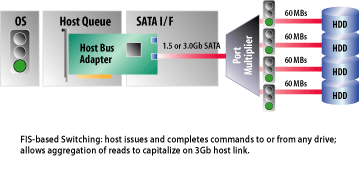
OCZ does have plans to sell a separate RAID card that’ll allow you stripe physical drives together—the board needs another logic chip to mux/demux the drives’ channels. The company knows that there are certain features that’ll need to be enabled if it hopes to see widespread adoption, and it says they’re being worked on currently. RAID support is one of those features. S.M.A.R.T. compatibility is another.
The IBIS drives don’t support TRIM in any form today. OCZ claims that this could potentially change in the future, but assume it won’t if you’re shopping around today. OCZ also makes no mention of idle garbage collection support, though past experience suggests this shouldn’t be a serious issue on a SandForce-based product. Should we experience performance degradation after prolonged use, we’ll make an update to this piece. Update: I followed up with OCZ, and it sounds like the SandForce controllers perform their own form of garbage collection, wrapped up into the DuraClass technology package. This should help maintain the drive's performance.
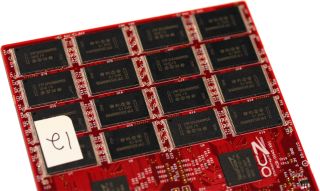
Also, be sure you’re dropping the IBIS into a system with ample system throughput. Naturally, using the drive on a P55-based platform already rocking a discrete graphics card is going to kill its performance (thank Intel’s chipset folks for that). You’d almost assuredly need an X58- or 890FX-based desktop platform, or something based on 5520 in the workstation space. Then again, if you’re in the market for a drive like this, “going cheap” probably wasn’t in the cards anyway.
The Future Of IBIS
In discussing IBIS, OCZ’s Ryan Petersen gave away some of the company’s plans for the drive’s future (it does seem to have a roadmap—it’s not a one-off product). While the architecture being used today is capable of up to 120,000 IOPS, OCZ expects to release a version in three months capable of twice that. From there, this first-gen HSDL implementation will be maxed out, and the interface speed will have to increase. Once they’re there, today’s hardware is going to get pushed down-market (a la Nvidia’s G92, for example), and a new generation will be launched up top.
-
Randomacts *faints* I will never be able to afford these.Reply
Those HDDs cost more then my entire comptuer -
randomizer Chris I think I'll need to double-check your results. Better send the drive my way.Reply -
mianmian Optic link technology may be more exciting. Can't wait to see lightpeak or similar stuffs to become real.Reply -
First time saw those numbers, i gasped for air... OCZ, can you try to saturated with PCIe 2.0 x16 bandwidth? And can anyone tell me how much is it in Write and Read speeds at that bandwith?Reply
-
wribbs Very nice to see secondary storage tech at orders of magnitude beyond what we're used to. Can't wait for this type of tech to become mainstream.Reply -
compton Stuff like this makes me wish I was involved in an enterprise-class technology environment that could actually benefit from 130,000 IOPS in a package like this. I guess I don't need to ditch my Agility 60, but I like where OCZ is headed.Reply -
h8signingin Yet there are already drives that outperform these by a large margin available for a while now, like this:Reply
http://www.superbiiz.com/detail.php?name=RGS0256M&title=Super-Talent-RAIDDrive-GS-256GB-RAID0-PCI-Express-x8-Solid-State-Drive
Read 1.4GB/s, Write 1.2GB/s
At those speeds, it's like writing to RAM, only it's your hard drive.
There were also capacities up to 1TB that cost about $4,000. There were even SLC models (which cost 4x more, approx. $15,000) which are slightly faster still.
Personally, I wouldn't mind having 1TB of "slow" RAM as my hard drive, but it's just beyond my budget. -
cangelini h8signinginYet there are already drives that outperform these by a large margin available for a while now, like this:http://www.superbiiz.com/detail.ph tate-DriveRead 1.4GB/s, Write 1.2GB/sAt those speeds, it's like writing to RAM, only it's your hard drive.There were also capacities up to 1TB that cost about $4,000. There were even SLC models (which cost 4x more, approx. $15,000) which are slightly faster still.Personally, I wouldn't mind having 1TB of "slow" RAM as my hard drive, but it's just beyond my budget.Reply
Yup, check it out! =)
http://www.tomshardware.com/reviews/super-talent-raiddrive,2513.html
Most Popular




